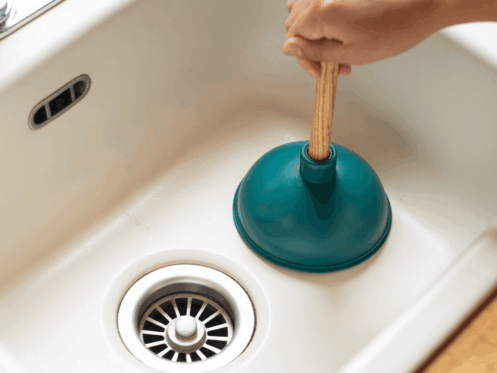At Quality Cooling & Heating, we understand that a clogged disposal can disrupt your daily routine and cause unnecessary stress. It’s a common issue that can lead to bigger plumbing problems if left unchecked. Knowing how to handle a clogged disposal is key to keeping your kitchen running smoothly.
In this article, we’ll explore why garbage disposals clog, share effective ways to unclog them, and offer tips to help you maintain a clear and efficient system. We’ll also discuss how to use garbage disposals responsibly, considering the environment and making sustainable choices for your home.
Understanding Clogged Disposal Issues
Garbage disposals are incredibly convenient, but they’re not invincible. Here are common culprits behind a clogged disposal:
- Food Waste: Items like potato peels and fibrous vegetables can accumulate and block the disposal.
- Grease: Pouring grease down the disposal can harden and lead to tough clogs.
When your disposal clogs, it affects your entire kitchen sink’s drainage. Slow or stagnant water can create unpleasant odors and even cause water damage. Addressing these issues promptly is crucial to prevent further complications.
Signs Your Garbage Disposal is Not Draining
Recognizing the signs of a clogged garbage disposal can save you time and hassle. Look for these indicators:
- Slow Drainage: Water draining slowly is a common sign of a clog.
- Unusual Noises: Grinding or rattling sounds may indicate an obstruction.
- Foul Odors: Bad smells often mean food particles are trapped.
- Water Backing Up: Water returning into the sink signals a blockage.
Ignoring these signs can lead to more serious plumbing issues. Prompt action can prevent costly repairs and keep your kitchen functioning smoothly.
How to Unclog Garbage Disposal Safely
Unclogging your disposal safely is possible with the right steps. Here’s how:
- Turn Off the Power: Always ensure the disposal is off. Unplug it or switch off the circuit breaker.
- Check for Obstructions: Use a flashlight to inspect inside. Remove debris with tools, not your hands.
- Use a Plunger: If water remains, try plunging. Ensure the sink is filled enough to cover the plunger cup.
- Reset the Disposal: Press the reset button located at the bottom of the unit.
- Use Baking Soda and Vinegar: Pour half a cup of baking soda followed by half a cup of vinegar. Let it fizz, then rinse with hot water.
Safety first—always follow these steps carefully. For more tips, refer to Safety Tips for Home DIY Projects – This Old House.
If these methods don’t work, it may be time to call a professional plumber to ensure your kitchen stays in top shape.
Kitchen Sink Clogged Tried Everything? Next Steps
If you’ve tried everything and your sink is still clogged, don’t worry. Here are some steps to consider:
- Check the Disposal: Make sure the disposal isn’t the clog source. Turn it off and inspect for blockages.
- Reset the Disposal: Sometimes a simple reset can solve the problem.
- Use a Plunger: Ensure enough water in the sink and plunge firmly.
- Try Baking Soda and Vinegar: Let the mixture sit before flushing with hot water.
- Professional Help: If issues persist, consider calling a professional plumber. For services in Georgetown, visit Plumbing Company Georgetown, TX or in Abilene, visit Plumbing Company Abilene, TX.
Regular maintenance can help prevent future clogs. For more tips, visit Plumbing System Maintenance | How to Prevent Clogs.
Environmental Considerations of Garbage Disposals
Garbage disposals are convenient, but they have environmental impacts. Here are some sustainable practices:
- Water Usage: Disposals use water, so operate them wisely to conserve resources.
- Waste Treatment: Food waste ends up in treatment plants, increasing energy use. Consider composting instead.
- Sustainable Practices: Avoid non-biodegradable items and stick to soft food scraps.
- Regular Maintenance: Keep your disposal clean for efficient operation and longevity.
For more on the environmental impact of garbage disposals, see Are Garbage Disposals Bad for the Environment? – Earth911.
Conclusion & Call to Action
Maintaining your garbage disposal is vital for a well-functioning kitchen and a healthy home. By understanding and addressing clogs, you can prevent most issues before they escalate. Additionally, being mindful of your disposal’s environmental impact can lead to more sustainable home practices.
If you’re in the Greater Austin area or Abilene, Quality Cooling & Heating is ready to assist. Whether it’s a stubborn clog or general plumbing maintenance, our team is committed to providing reliable, community-focused services. Contact Quality Cooling & Heating today for professional plumbing services that ensure your home’s comfort and safety. For more on trenchless sewer replacement benefits in Austin, visit Austin Trenchless Sewer Replacement Benefits.


